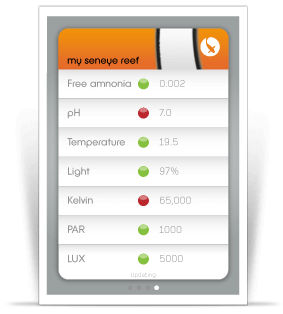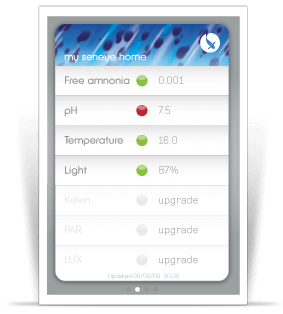why seneye?
We buy a fish tank to hold water, then a heater or chiller to keep the temperature constant, filters to keep the fish from becoming poisoned, along with lights for illumination and plant growth. Then we spend a fortune on fish, coral, plants and décor which we become very attached to. The next step is to cross our fingers and hope for the best or spend half our lives using test kits. There is an alternative, let seneye protect your loved ones.
Parameters Monitored
No aquarium or pond however mature can be guaranteed as stable and never to crash. Changes in water parameters are bad and can affect aquarists from novice to professional. A range of things from poor aquarium husbandry to equipment failure can cause swings in water parameters and harm your fish. A seneye constantly watches for these changes which are undetectable to the human eye. Seneye monitors the following parameters which are critical to aquatic life and likely to change fast when something does go wrong.

temperature
Temperature is one of the most important environmental factors in the aquatic environment. Aquarists keep fish from all over the world and they have different requirements on temperature. Pond temperature can swing greatly and this can have major effect on fish, metabolic rates, biological filter activity and oxygenation. Often heaters and chillers are used to control temperature but no matter how expensive your equipment it will eventually stop working; when it does you will wish you had a warning device to let you know things weren’t right where ever you happen to be.



pH
pH in an aquarium or pond is very important to understand as many fish live in a specific range. Fish are very good at adjusting to pH levels but sudden change can kill. For this reason watching for change and understanding fluctuations is most important. ph will constantly change in any aquarium so taking a reading once a week or month may not show you what the real pH is. The only way to protect your fish.

ammonia
Free ammonia NH3 is a gas and the number 1 killer of fish. All fish excrete ammonia as a waste product and if it builds up in water it will become toxic. Aquarium filters are designed to convert or remove ammonia through biological activity or absorption. Rarely tested for in mature aquariums NH3 is viewed as a ‘new tank’ issue; the reality is any aquarium filters can stop functioning and NH3 is the first indicator that something has gone wrong. If you wouldn’t dream of keeping fish without a filter you should invest in making sure it’s working.
Traditionally NH3 is very hard to measure and confused with NH4 total ammonia (ammonium). NH3 is free ammonia and it is often confused with NH4 total ammonia. Free ammonia forms part of Total ammonia but it is the only toxic part. Free ammonia forms an equilibrium with total ammonia based on pH and temperature. Most ‘ammonia’ test kits measure NH4 and expect you to work free ammonia out. Causes of NH3 raise chemicals destabilising the environment, filter stopping, adding more fish, water changes to a higher pH, insecticides etc.
